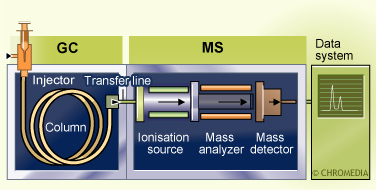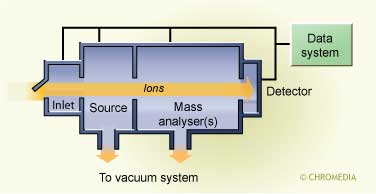A powerful technique
The combination of the separation power of capillary GC with the identification abilities of Mass Spectrometry provides us with probably the most powerful separation-identification technique available today. Capillary GC by itself can offer strong evidence of identity from retention characteristics, particularly if the source of the sample is known, but this evidence is never conclusive and would never be accepted as a legal proof of identity. Such situations are commonplace in environmental monitoring where samples are frequently complex. It is essential that levels of toxic compounds in atmospheric emissions, aqueous discharges, etc, are kept below specified limits, but these will often co elute with other compounds when subjected to capillary GC.
Also FTIR (GC-Fourier Transformed InfraRed spectrometry) can be coupled. Also NMR (Nuclear Magnetic Resonance) is a powerfull technique for additional spectroscopic information in analytical chemistry. Both techniques provide excellent, additional information in structure elucidation of unknown compounds. The use of selective or specific detectors which only respond to the compounds of interest can sometimes help but the most acceptable option is to apply GC-MS.
GC-MS
MS was a well established technique long before the advent of GC but has always involved complex and expensive instrumentation. It is not surprising therefore that in coupling the two techniques together considerable progress has been made in the development of economical GCMS combinations using several techniques in the sequential processes of ionization, ion focusing, and detection. The last 10-15 years GC-MS systems have become smaller, users friendly and affordable, so they are used nowadays in many routine laboratories.
Scheme of the mass spectrometer
Capillary GC columns are very well suitable for combination with a mass spectrometer as GC detector. Mainly narrow-bore columns (0.25 mm I.D.) are used because of the relative low gas flow rate of approximately 1 ml/min He.
The GC-MS is not only very sensitive and selective, but also provides MS spectra, which are very helpful in confirmation and identification of the chemical structure of the eluting peaks from the column. Large digital libraries of spectral data support this very powerful technique.
 Did you ever try to explain separation to your employees or students? Well, try no more: Lee Polite did it for you in a way which is hard to beat. We will open up one example of his whiteboard class.
Did you ever try to explain separation to your employees or students? Well, try no more: Lee Polite did it for you in a way which is hard to beat. We will open up one example of his whiteboard class. 




